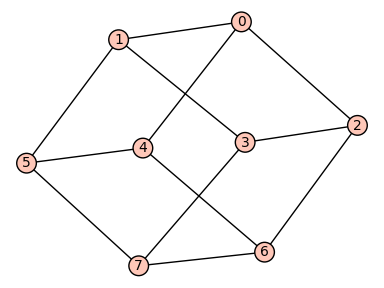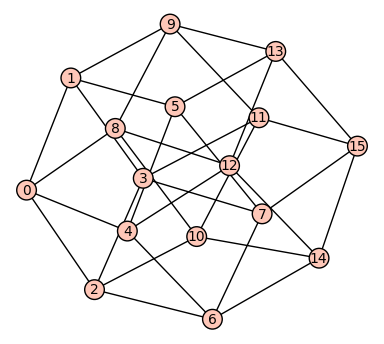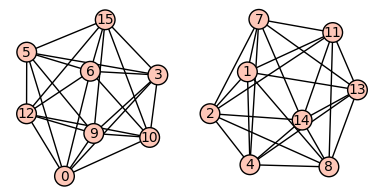This section provides some examples on Chapter 2 of Stanley’s book
[Stanley2013], which deals with
The vertices of the
sage: def dist(u,v):
....: h = [(u[i]+v[i])%2 for i in range(len(u))]
....: return sum(h)
>>> from sage.all import *
>>> def dist(u,v):
... h = [(u[i]+v[i])%Integer(2) for i in range(len(u))]
... return sum(h)
def dist(u,v):
h = [(u[i]+v[i])%2 for i in range(len(u))]
return sum(h)
The distance function measures in how many slots two vectors in
sage: u = (1,0,1,1,1,0)
sage: v = (0,0,1,1,0,0)
sage: dist(u,v)
2
>>> from sage.all import *
>>> u = (Integer(1),Integer(0),Integer(1),Integer(1),Integer(1),Integer(0))
>>> v = (Integer(0),Integer(0),Integer(1),Integer(1),Integer(0),Integer(0))
>>> dist(u,v)
2
u = (1,0,1,1,1,0) v = (0,0,1,1,0,0) dist(u,v)
Now we are going to define the
sage: def cube(n):
....: G = Graph(2**n)
....: vertices = Tuples([0,1],n)
....: for i in range(2**n):
....: for j in range(2**n):
....: if dist(vertices[i],vertices[j]) == 1:
....: G.add_edge(i,j)
....: return G
>>> from sage.all import *
>>> def cube(n):
... G = Graph(Integer(2)**n)
... vertices = Tuples([Integer(0),Integer(1)],n)
... for i in range(Integer(2)**n):
... for j in range(Integer(2)**n):
... if dist(vertices[i],vertices[j]) == Integer(1):
... G.add_edge(i,j)
... return G
def cube(n):
G = Graph(2**n)
vertices = Tuples([0,1],n)
for i in range(2**n):
for j in range(2**n):
if dist(vertices[i],vertices[j]) == 1:
G.add_edge(i,j)
return G
We can plot the
sage: cube(3).plot()
Graphics object consisting of 21 graphics primitives
>>> from sage.all import *
>>> cube(Integer(3)).plot()
Graphics object consisting of 21 graphics primitives
cube(3).plot()

sage: cube(4).plot()
Graphics object consisting of 49 graphics primitives
>>> from sage.all import *
>>> cube(Integer(4)).plot()
Graphics object consisting of 49 graphics primitives
cube(4).plot()

Next we can experiment and check Corollary 2.4 in Stanley’s book, which
states the
sage: G = cube(2)
sage: G.adjacency_matrix().eigenvalues()
[2, -2, 0, 0]
sage: G = cube(3)
sage: G.adjacency_matrix().eigenvalues()
[3, -3, 1, 1, 1, -1, -1, -1]
sage: G = cube(4)
sage: G.adjacency_matrix().eigenvalues()
[4, -4, 2, 2, 2, 2, -2, -2, -2, -2, 0, 0, 0, 0, 0, 0]
>>> from sage.all import *
>>> G = cube(Integer(2))
>>> G.adjacency_matrix().eigenvalues()
[2, -2, 0, 0]
>>> G = cube(Integer(3))
>>> G.adjacency_matrix().eigenvalues()
[3, -3, 1, 1, 1, -1, -1, -1]
>>> G = cube(Integer(4))
>>> G.adjacency_matrix().eigenvalues()
[4, -4, 2, 2, 2, 2, -2, -2, -2, -2, 0, 0, 0, 0, 0, 0]
G = cube(2) G.adjacency_matrix().eigenvalues() G = cube(3) G.adjacency_matrix().eigenvalues() G = cube(4) G.adjacency_matrix().eigenvalues()
It is now easy to slightly vary this problem and change the edge
set by connecting vertices
sage: def cube_2(n):
....: G = Graph(2**n)
....: vertices = Tuples([0,1],n)
....: for i in range(2**n):
....: for j in range(2**n):
....: if dist(vertices[i],vertices[j]) == 2:
....: G.add_edge(i,j)
....: return G
sage: G = cube_2(2)
sage: G.adjacency_matrix().eigenvalues()
[1, 1, -1, -1]
sage: G = cube_2(4)
sage: G.adjacency_matrix().eigenvalues()
[6, 6, -2, -2, -2, -2, -2, -2, 0, 0, 0, 0, 0, 0, 0, 0]
>>> from sage.all import *
>>> def cube_2(n):
... G = Graph(Integer(2)**n)
... vertices = Tuples([Integer(0),Integer(1)],n)
... for i in range(Integer(2)**n):
... for j in range(Integer(2)**n):
... if dist(vertices[i],vertices[j]) == Integer(2):
... G.add_edge(i,j)
... return G
>>> G = cube_2(Integer(2))
>>> G.adjacency_matrix().eigenvalues()
[1, 1, -1, -1]
>>> G = cube_2(Integer(4))
>>> G.adjacency_matrix().eigenvalues()
[6, 6, -2, -2, -2, -2, -2, -2, 0, 0, 0, 0, 0, 0, 0, 0]
def cube_2(n):
G = Graph(2**n)
vertices = Tuples([0,1],n)
for i in range(2**n):
for j in range(2**n):
if dist(vertices[i],vertices[j]) == 2:
G.add_edge(i,j)
return G
G = cube_2(2)
G.adjacency_matrix().eigenvalues()
G = cube_2(4)
G.adjacency_matrix().eigenvalues()
Note that the graph is in fact disconnected. Do you understand why?
sage: cube_2(4).plot()
Graphics object consisting of 65 graphics primitives
>>> from sage.all import *
>>> cube_2(Integer(4)).plot()
Graphics object consisting of 65 graphics primitives
cube_2(4).plot()
